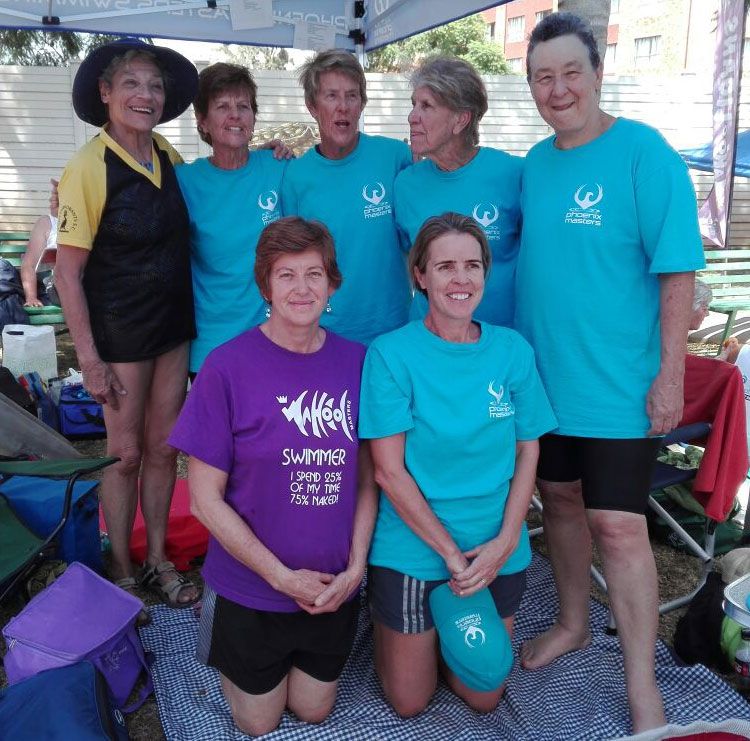Susan Roberts
Sue was born in 1937 and finished matric at Roedean School in Johannesburg in 1955, where she was coached by Cecil Colwin.
She was 19 years old at the 1956 Olympic Games in Melbourne, where the Springbok ladies 4x100 meters freestyle relay squad (with Moira Abernethy and Jeanette and Natalie Myburgh) won third place for the bronze medal.
She also competed individually in the 100 and 400 m events but did not reach the final of either. Her other major tournament was the 1958 British Empire and Commonwealth Games, where she finished fourth in the 4×110 yards freestyle relay (with Natalie Myburgh and the non-Olympians M.M. Hogg and S.G. Wetton) and fifth in the 4×110 yards medley relay (with Wetton, Natalie Myburgh and the non-Olympian J. Rocchi).
Roberts was also eliminated in the heats of the 110-yard freestyle, the 440-yard freestyle, and the 110-yard backstroke. Between 1955 and 1958 she earned numerous Transvaal provincial and South African titles and set several records across various individual disciplines.
She entered Cape Town University in 1956 to earn a social science degree and was active on the school’s swimming and badminton teams.
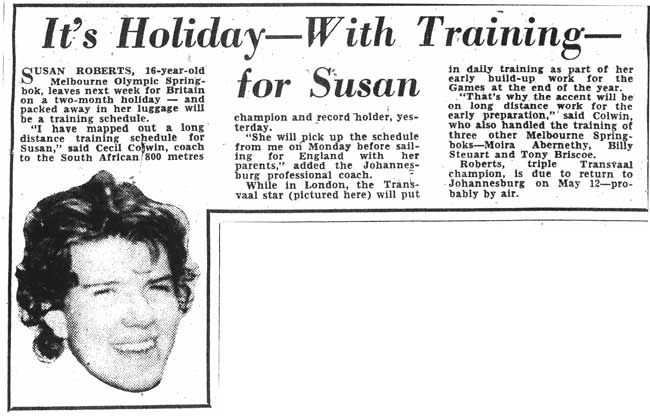
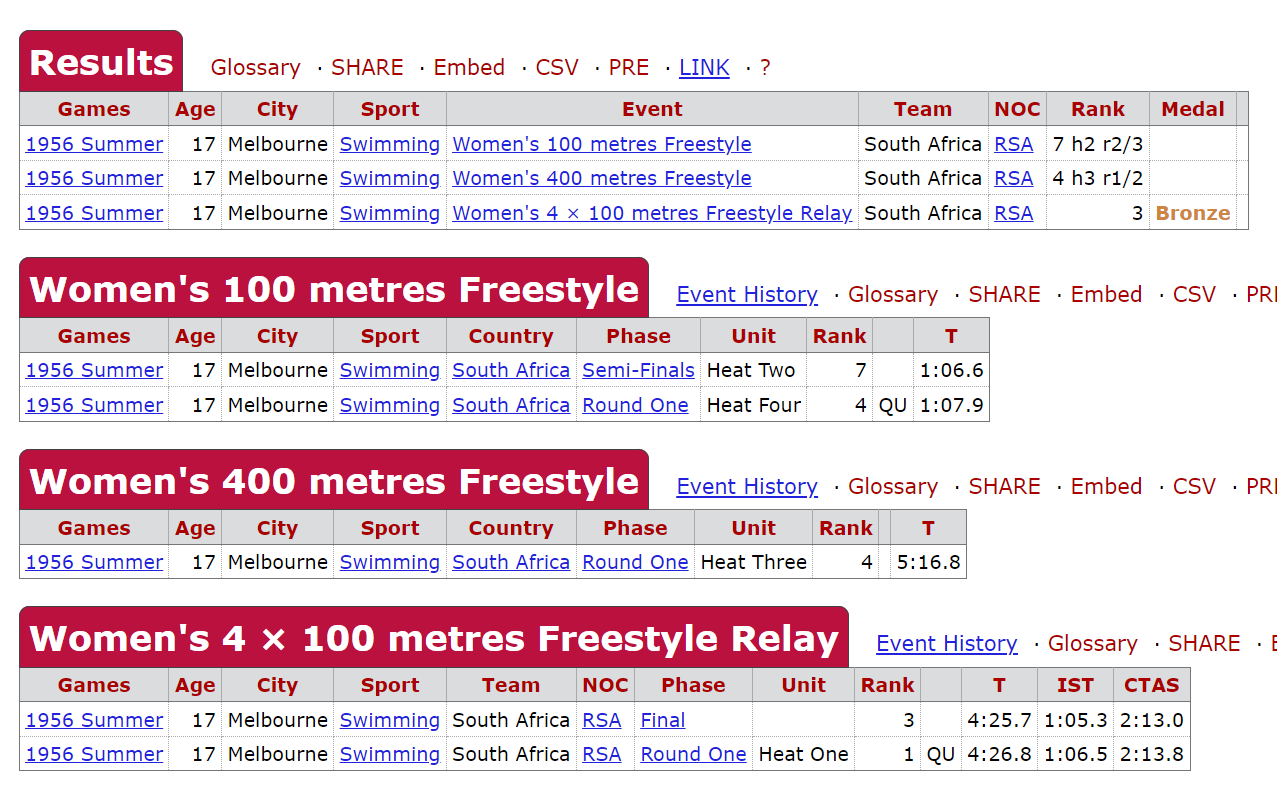
Roedean Old Girls make a splash at Masters Swimming Champs
APR 6, 2018
Congratulations to Jane Asher (Matric1947), Jane (Roberts) Hulley (Matric 1959), Anne (Roberts) Jones (Matric 1961), Susan (Roberts) Leuner (Matric 1955), Marissa Rollnick (Matric 1968), Sandra Murray (teacher at Roedean), and Charlotte Hulley (Honorary Old Girl) who recently took part Masters National Swimming Championships held in February 2018.
Roedene school pool long ago, and the pool today.
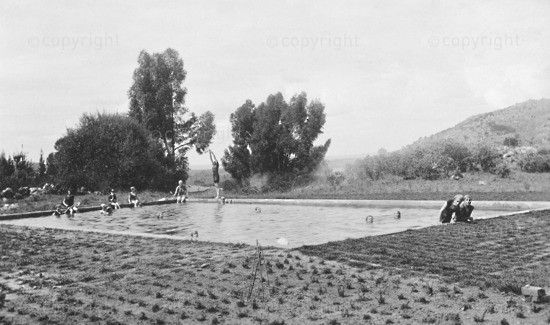
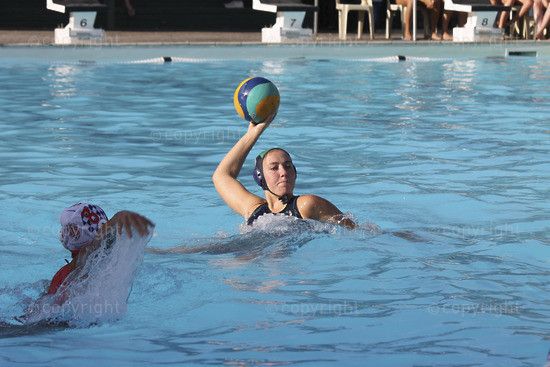
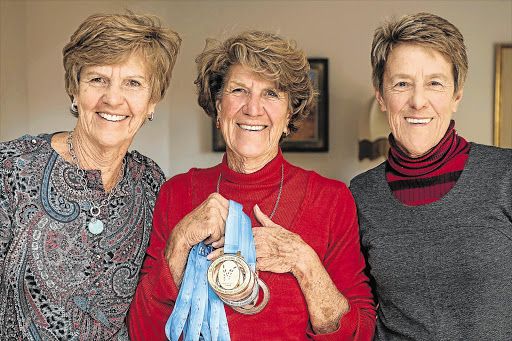
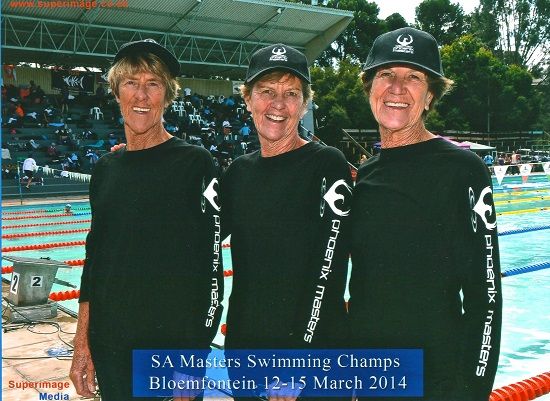
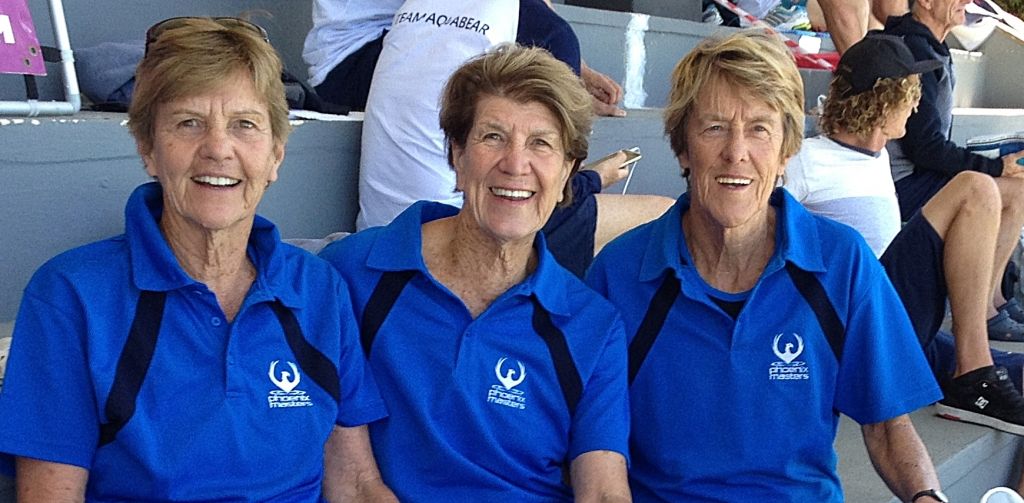
Winning strokes from older folks
31 Aug 2014
BY DAVID ISAACSON
SWIMMER Sue Leuner is still winning medals for South Africa - 58 years after bagging an Olympic bronze at the Melbourne Games. She landed five freestyle gongs in the 75-79-year-old category at the recent world masters swimming championships in Montreal, and the 100m gold was inspired by one of her old Games comrades.
Leuner (her maiden name was Roberts) was 17 when she teamed up with Toy and Jenny Myburgh (no relation) and Mo Abernethy to finish third in the 4x100m freestyle relay behind hosts Australia and the US at the 1956 showpiece.
Toy has since died, but the surviving three have remained close friends and shortly before leaving for Canada, Leuner was chatting to Abernethy.
"I told her, 'I'm really nervous - I'm looking forward to the trip, but not to the swimming'," says Leuner, whose two younger sisters, Jane Hulley and Anne Jones, also competed in Canada.
"Then Mo asked me: 'Don't you like racing?' I had never thought about that," admits 75-year-old Leuner, who chose to adopt some joie de vivre.
She won the 100m in 1min 26.34sec, more than three seconds quicker than her nearest rival and one of the fastest-ever swims for her age group.
While it was understandably slower than the 62-odd seconds she used to clock at her peak, that time would have been good enough for a bronze at the 1912 Olympics, when female swimming was first admitted to the Games.
Sue, Jane and Anne were encouraged to do sport by their construction king father Douglas Roberts, of Murray and Roberts, who taught them to surf, among other things.
"Our father was an absolute sports fanatic," says Anne. "Luckily he didn't like rugby," jokes Jane.
He had planned to go to Melbourne to watch Sue compete, but had to stay home after falling ill.
With no TV in South Africa, he, Jane and Anne listened to the commentary on a ham radio given to them by legendary SABC commentator Charles Fortune.
"The commentary was in Chinese or Japanese," recalls Anne. "All we heard was chi-chi-chi-chi Roberts, chi-chi-chi-chi Abernethy, chi-chi-chi-chi Myburgh."
It was a different era back then. For one thing, the South African team's trip to Melbourne took five days, with overnight stops in Mauritius, the Cocos islands and Darwin, where the plane broke down and had to be repaired before continuing.
The prevailing attitude about sex was far more conservative than now. Today condoms are distributed in Olympic villages for athletes to use as they please.
In 1956, however, the men's and women's sections were separated by a chicken-wire fence. "It was said that the fence was two inches higher than the world pole vault record," Sue says with a laugh.
In her Olympic scrapbook she has a photo of a man and a woman cosying up to each other on opposite sides of the barrier.
Sue also experienced the growing tide of anti-apartheid sentiment in Melbourne, being booed when she was introduced before one of her individual races (she progressed to the semifinals of the 100m freestyle).
On one trip with her father, travelling via India, she saw the famous sign in an airport transit lounge, reading: "No dogs or South Africans."
But what seems to have remained unchanged all these years is South Africa's poor sports administration.
Five of SA's eight Olympic swimmers, including Sue, had spent their careers training under coach Cecil Colwyn, a forward-thinking mentor who went on to enjoy widespread acclaim.
A further two members joined their squad several months before the 1956 Games, meaning Colwyn was coaching seven of the eight, but he was overlooked as the team coach/manager.
"I don't remember the reason," says Sue, "but it was shocking."
Matters didn't improve for the 1958 Commonwealth Games in Wales with the selectors failing to enter a freestyle relay team and Abernethy and Jenny Myburgh being left at home.
That surely cost South Africa a silver medal - the relay team's time from Melbourne was five seconds faster than Canada, who placed second behind Australia in Cardiff.
As a swimmer Sue overshadowed her sisters. Next best was Anne, who competed for then Transvaal. "I was always introduced as the sister of Sue Roberts."
Anne, now 69, moved straight into masters swimming and became a familiar face in those circles, while Sue got involved only in the mid-1990s.
At her first masters gala the Olympic medallist was asked by an unsuspecting participant: "So, Sue, do you also swim?"
Swimming internationally at masters Leuner has come up against one former Olympic rival. At a previous world championships she got chatting to Germany's Christel Schultz, who had competed in the 4x100m relay in 1956, and winning bronze in the same relay at the 1960 Rome Games.
The oldest competitor in Montreal this year was a 97-year-old New Zealander who, in the 200m and 400m freestyle races, stopped after every 100m to ask if she had swum far enough.
She was the only entrant in the 95-99 category.
Anne points out that initially the oldest masters age group was 90-plus, but extra categories were added some 15 years ago after a 98-year-old man had complained of having to compete against "a youngster of 92".
For Jane, 71, Montreal was her first swimming competition since university. "I decided only in September to go to Montreal. For the first two weeks of training I thought I was going to drown."
The Montreal gala attracted some 8,000 swimmers. By comparison, fewer than 3,500 athletes competed at Melbourne 1956, although by London 2012 this number had grown to more than 10,500.
Anne, a swimming coach at Roedean school, insists there is something special about the sport. "In a pool you feel ageless," she says.
"We don't feel old," adds Sue. "I just think the stop watches are a lot faster these days."
https://www.timeslive.co.za/sunday-times/lifestyle/2014-08-31-winning-strokes-from-older-folks/
Strokes of genius
Jul 1, 2014
When a three-year old girl was taught to swim by her cousin in their fishpond, she could not know that she would be swimming in an international Masters competition at the age of 75!
A local family – the Roberts sisters: Sue, Jane and Anne – competed against the world’s best in their age group in the World Masters Swimming Championships in Montreal, Canada in August – appropriately, the month in which we celebrate women in South Africa.
How did this amazing trio of siblings come to achieve this astounding feat?
Sue Leuner (nee Roberts), fell in love with swimming following her lessons in the fishpond, and was spotted by a coach at a school interhigh gala at the age of 14. This led to her competing in the Olympics in Melbourne Australia in 1956 at the age of 17, and the Commonwealth Games in Cardiff, Wales in 1958. Sue recalls the rigorous training she underwent: “The family went on their December holiday and I stayed behind to train at the Hillbrow swimming pool. We had a coach and trained twice a day – in many ways, we were ahead of the trend that was just taking hold of the world.”
Then, for some years, Sue allowed her swimming talent to lie dormant, despite having achieved her Springbok colours. Life was full – she was studying at the University of Cape Town, majoring in Social Science in the absence of the availability of her first choice: physiotherapy. She also found Personnel Management appealing, and discovered that Harvard Business School offered a general course in business administration on their Radcliffe campus in Boston – a one-year programme for women who, at that time, were excluded from attending the business school. “Despite having relinquished my swimming career, I was quite envious of my friends who had been involved in something like tennis or hockey – that enabled them to continue enjoying their sport long after we’d given up rather boring training.” she says.
A tumble-turn
A change came about when, in 1994 Sue’s sister, Anne, participated in the world masters swimming championships and urged Sue to go with her to the Pan American Games in Hawaii the next year. Sue decided to join her in her training regime –they swam in the sea, the lagoon, the pool. But then the Games were cancelled. Sue was told, “Don’t worry … come to Nelspruit for the SA champs instead!” What a disappointment – but by that time she was hooked and had her first masters experience.
“I knew then that this was my element, something that just came naturally to me,” she says.
The two sisters went on to compete in the world championships in 1996 in Sheffield,and in Munich in 2000, but that marked the end of Sue’s swimming for that time. Two years ago, Anne (then 66 years of age) started a swimming school at Roedean School in Houghton to train the learners – she started 5:00 and 7:00 classes for the parents, on either side of the 6:00 lesson for the children. “I joined the 5:00 class and fell in love with swimming again – there is nothing like the feeling of the early morning: the sunrise, with the sound of the birds, and the feel of the warm water,” says Sue.
“When my husband, Rupert, asked what we were doing all this training for, and offered to send us to the international competition which was two years hence, we laughed. But, with time, the idea grabbed us and about a year ago we established contact with an e-coach in Pretoria, Annemarie Dressler, who sends us schedules by email, and who will be accompanying us to the world championships.”
Annemarie keeps the Roberts ladies exercising: two days of gym and three days of swimming each week. Annemarie herself is an inspiration, having contracted cancer some years ago, and, determined to be well again, she revolutionised her life by learning about nutrition and exercise, and how the body responds. She has focused on biokinetics and exercise as one ages, and completed her Masters in this subject at the age of 50. Then the third sister, Jane, decided she wasn’t going to be left out so she started training with Mrs Wendy Ray, swimming in Camps Bay in Cape Town and is doing very well despite not training for swimming since her UCT days. She is very fit though, even completing the Argus at the age of 70!
What women can achieve
We asked Sue about her goal for the Championships. “I would love to be in the top three for my events, but definitely hope for top ten medals. The top 10 swimmers in every category win a medal. Top ten times each year are available on the internet so I am aware of the times, but not of who will be participating.” Sue has a greater chance of winning a medal, she says, as she is in an older age category, where there is less competition – her sisters will experience a greater challenge!
Sue shared a message for women in particular. “I am so lucky to have been born a woman – I have avoided the fighting in the marketplace and the testosterone to get to the top! Women are extra-ordinarily brave. My father wanted me to be an engineer, but you must go where your heart is – I loved business. When I returned from Harvard, I joined the IDC (Industrial Development Corporation) at the same time as two men – I was 22 and they were in their late twenties. I knew more about the job than they, but I earned half their salary. This did not bother me as I had already adopted an attitude that recognised that they would probably have this career for the rest of their lives; I, on the other hand, could look forward to a varied life: marriage, children, and opportunities yet to be discovered.”
Sue and her sisters, Jane Hulley and Anne Jones flew to Montreal on 31 July. They participated in the all freestyle, 800m, 400m, 200m, 100m and 50m events. At the time of writing this article, we were awaiting news of their achievements! As we celebrate women and all they bring to our world, we wish these amazing sisters even greater triumphs going forward!
Susan Leuner (Phoenix member) born 21/4/1939 Sue has had a remarkable illustrious swimming career going back to the 1950s. After mixing it up with the brave she earned her Springbok colours. Remember back then there were no ear/nose plugs, goggles, caps, heated pools, ‘Go faster’ Speedo’s. Lane ropes were cork floats, strung together with string that had no effect on protecting a swimmer from the turbulence in the lanes on either side of you. You could almost surf in the end lane, as the water bounced off the scupper. Sue persevered sometimes reeking of chlorine and her hair going green. Sue, was one of our last lady swimming medallists to attend an Olympics before South Africa was unceremoniously dumped out in 1964.
She swam in the 1956 Olympics (Melbourne) and was part of the ladies 4 x 100 freestyle relay team that won Bronze. This was the only medal SA won in swimming and our last Olympics swimming medals for a long while. The “Fab Four” consisted of- Natalie Myburgh, Susan Roberts, Moira Abernethy and Jeanette Myburgh. If one was a swimmer in the mid to late 50’s, these names were legendary. And still are.
Sue has been swimming Masters for a number of years and has received her South African colours almost every year that she swam. She took a break but returned with a vengeance in Bloemfontein 2014. Sue was one of the outstanding swimmers at Nationals in Bloemfontein where she broke SAM’s records in all 6 of her individual events in the 800/400/200/100 and 50 free and 50 Fly. She was also part of 2x 280+ relay teams that broke SA records at Nationals. So in total, at one nationals, Sue broke 8 SA Records. Another remarkable feat for this kind unassuming lady of the pool. She received SAMS and GMS colours once again this past season. Every time Sue swims SAMS and GMS records are broken. Phoenix is very proud to have Sue as part of our team. Sue with sisters Anne Jones and Jane Hulley are all going to World Masters Championships in Montreal...we expect great things from her and the sisters. All the very best to the three of you. We will be watching in anticipation.</p>

